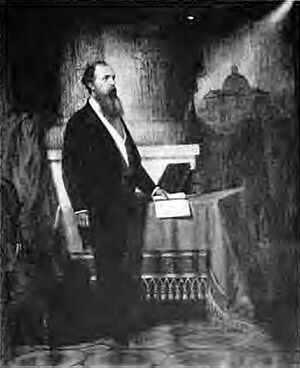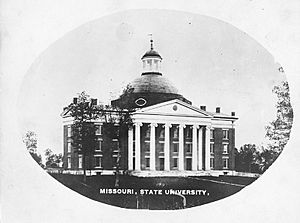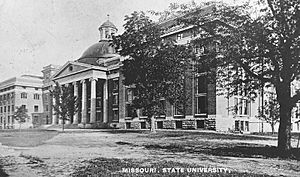Academic Hall facts for kids
Academic Hall was the very first main building at the University of Missouri. It was officially opened in 1843. Sadly, a big fire destroyed it in 1892. Today, the six tall Ionic columns from Academic Hall are still standing. These columns, now called The Columns, are a famous symbol of the University of Missouri. You can find them on Francis Quadrangle, which is the oldest part of the campus.
Contents
The Story of Academic Hall
Building Academic Hall
Academic Hall was built between 1840 and 1843. The plans for the building were drawn by Stephen Hills. He also designed Missouri's first state capitol building.
The building was officially opened in 1843. It had a round, domed center section with three floors. Two extra sections, called wings, were added in 1885. Academic Hall was used for both classes and university offices. The bricks for the building were made right on campus. The limestone for the famous Columns came from a nearby valley. Ox-drawn carts carried the heavy stones to the building site.
Academic Hall During the Civil War
The American Civil War started in 1861. Missouri was a "border state," meaning it was between the North and the South. Columbia, where the university is, had many people who supported the South. Because of this, the United States government watched the university closely.
During the war, soldiers from the Union army stayed in Columbia. They used university buildings, including Academic Hall, as their living quarters. Union troops even held Confederate prisoners in the main library on the third floor. Classes at the university stopped for 10 months because of the soldiers and because many staff members left to join the war.
The Union troops caused some damage. They used 467 books from the library to start fires. The university asked the government for money to cover the damage. In 1915, the government agreed to pay. This money was later used to build the Memorial Gateway on campus.
The Great Fire of 1892
On a Saturday evening, January 9, 1892, Academic Hall caught fire. People said the fire might have started because of the first electric light bulb west of the Mississippi River. An event was about to start in the chapel. As people gathered, a small fire appeared around a large light fixture.
Workers tried to put out the fire. They cut a hole in the floor above and used water from the building's water system. But the water quickly ran out, and the fire kept growing. By midnight, the fire had completely destroyed the building. Only the six stone Ionic columns were left standing. The fire even spread to the president's house nearby, but it was put out without much damage there.
Most of the books in the main library were lost. Only the books that people had checked out were saved. Some items from the law library were also saved. The museum wall was broken, and exhibits, like a large elephant statue, were pulled out into the snow.

After the fire, some people wanted to move the university to a different city called Sedalia. But the people of Columbia worked hard to keep the university in their town. The Columns, which are still there today, became a symbol of the campus. They stand in the middle of Francis Quadrangle, the oldest part of the university.
For a while, some people thought the Columns were ugly. They blocked the view of new buildings being built. Some even worried they might fall down and be dangerous. In 1893, the university leaders decided to tear them down. A local newspaper reported that two teams of mules were ordered to pull them down.
But a local citizen named Jerry S. Dorsey led a protest. He said "the Columns could not be pulled down by a herd of elephants!" The university leader, Gideon F. Rothwell, said he would even use dynamite to remove them. Dorsey got a court order to stop the destruction. An expert then said the Columns were safe and strong. Because of the protests and the expert's opinion, the university leaders changed their minds. In December 1893, they decided the Columns would stay.






